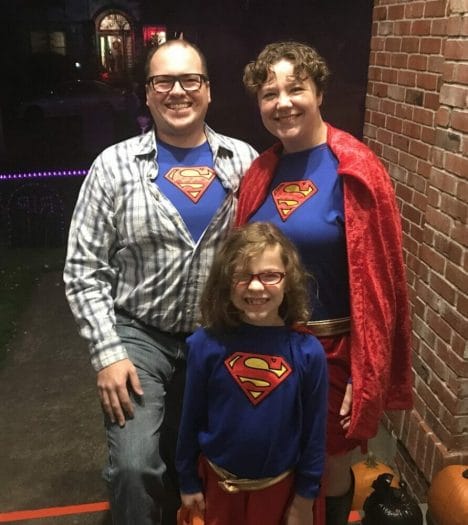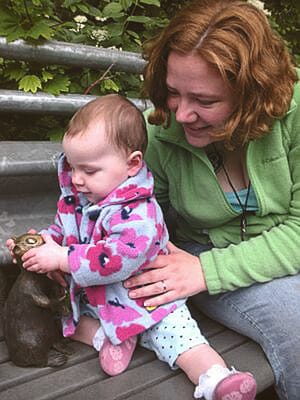Ruby LOVES switching the television on and off with the remote and does it any chance she gets! When the remote was placed in front of her and she wouldn’t even reach for it, we knew something was definitely wrong. She would not smile, crawl or play with toys. A very active and happy baby, that day Ruby just wanted to be held. Trying to tell the whole story with all that was going on feels like kind of a blur. But we were there with our daughter and definitely remember it.
We’d taken an overnight trip to the coast June 5th and 6th, and had been to the Oregon Zoo early on the 7th. Later that evening, Ruby started showing signs of not feeling well — having diarrhea and being warm to the touch. We figured she was just teething. Over the next few days she ran a slight fever (around 100°F) and had increasing diarrhea. By June 11th we knew it was something more. Her fever had crept up over 101°F, her diarrhea had increased, and she was lethargic. Since our pediatrician’s office is closed on weekends, I packed Ruby up and took her straight to Urgent Care where her fever had increased by the time we’d gotten checked in. Checking for a urinary tract infection, the attending physician took a sample. When it came back negative, she said it was likely just a virus. The doctor instructed us to,“give Ruby Tylenol around the clock,” for a few days and, since she’d had a prolonged fever, be sure she was getting enough fluids to prevent dehydration. She should be better in a couple days we were told. So we took her home and kept up the Tylenol. After 20 diarrhea-filled diapers that Saturday, four just while at the doctor’s, she seemed to be feeling better. On Sunday she was more responsive.

By the time Monday arrived, I noticed she wasn’t eating quite as much as normal. My husband, Brandon, went to the store for Pedialyte to help prevent dehydration but Ruby wouldn’t drink it. The Tylenol was keeping the fever under control but she was still having diarrhea. Tuesday she wanted nothing to do with food, so I called and got an appointment with our pediatrician. The doctor looked her over and ordered urinalysis and blood tests. We had just finished at the lab when the doctor hurried over and asked if we would be willing to allow yet another test, so we agreed to let them stick Ruby with the needle one more time. That test, I believe, is the one that saved Ruby’s life. Our doctor noticed how worried we were, so she asked the lab to call us later that night and let us know if they had any results. Around 10 o’clock I received a call and was told that only half the labs had come in but that everything was looking normal. So the next day, being scheduled for an evening shift, I decided to go to work. Brandon works nights and I work days so there is always someone home with Ruby. I was sitting in the break room having dinner when my phone rang. I said, “Hello,” and the woman who’d given us the results the night before said, “Get Ruby to the hospital now. She has bacteria in her blood and needs antibiotics.” As my heart started racing I asked how serious it was and was told, “Take her there immediately!”

I rushed out of work, drove home, and packing up Brandon and Ruby headed towards the medical center. As we pulled onto the freeway I got a call saying she would need overnight care and that we needed to go to the Children’s Hospital at Oregon Health and Science University (OHSU). I was so glad Brandon was driving because the worry and stress had caught up with me. So many questions going through my mind — How did she get this? What exactly is it? Was it something from the Coast? Or the Zoo? Will she be OK?
When we arrived at OHSU, Brandon dropped us off at the Emergency door for admittance because it was after normal hours. First, we were sent to a special waiting room for children. We were finally taken to an exam room, but by then Ruby’s temperature had reached 104.1°F. Tylenol was quickly administered. They said that if her fever had gotten much higher she could have had a seizure. We answered questions about what Ruby had eaten and come into contact with for the week or so prior to being sick. After a tech took some x-rays we waited to be fully checked in and taken to a room. The utterly helpless feelings of my baby girl painfully, miserably cuddled up on my chest and me, sitting there waiting, knowing there is nothing I can do to help, is an experience I never want to go through again.

The minutes ticked by slowly until we were admitted and given a room. Ruby was in isolation, we were told, and she couldn’t leave. When the doctor came by we wanted to know exactly what was going on. There were bacteria in her blood and it would be 24 more hours before we knew what kind, but until then she was going to start on Ceftriaxone. He didn’t know if the bacteria would respond to the Ceftriaxone, but it was, “a good broad-spectrum antibiotic”. Hearing the doctor say, “I don’t know,” was terrifying.
After they hooked her up to an IV for both antibiotics and hydration, I really felt for her. Getting an IV hurts –- during Ruby’s stay in the hospital she had three different IVs — in her hand, in her arm and once in her foot. The constant readjusting of the tape in an effort to let her move around and sleep was very painful for her. She didn’t understand what was happening and she kept trying to chew on the IV line. I slept in the chair right next to her bed because she would roll in her sleep getting the tubes wrapped around her or pinching them.
She’d been sleeping for a couple hours when the nurse came in to take her temperature. Even with the Tylenol it was over 101°F so they started giving her Motrin as well. The constant rotation between Motrin and Tylenol to control her fever continued for five more days. A nurse would check in every two hours gauging blood pressure, temperature and blood oxygen, during which time Ruby would usually wake up. Sometimes, when they finished, she would just go back to sleep and other times take an hour to get settled again. Every used diaper was checked and weighed making sure she was getting enough liquids. Every time she ate I’d note the amount and it would be recorded. She barely ate for the first four days. By the fifth she was so hungry she ate a whole bottle and promptly threw it all up. She had at least 5 diarrhea diapers a day and, no matter how much Desitin we slathered on, the diaper rash was constant. She spent hours on my chest sweating and lethargic. And every morning a nurse came by for a blood sample. How do you explain to a 10-month-old that sticking a needle in them was for their own good? Every time a nurse came and dropped the side of the crib, she cried. All the pain, exhaustion, crying, and fevers made the agonizing days blend together.

On June 17th, we figured we would finally start getting some answers. They had confirmed bacteria in the blood and were identifying what exactly it was and what would work best against it. On the 18th, we were finally informed that she had Salmonella Heidelberg and that they were testing its susceptibility to different antibiotics. (It wasn’t until 2 months later that it was determined that it came from ground turkey, which we’d used in meatballs with spaghetti the night before we’d left for the coast.) A CDC doctor spoke with us about the details of Salmonella, saying blood and stool cultures would be taken and that when they had been negative for 48 hours we could take her home and continue administering antibiotics there. On Sunday, June 19th, we were told it had come back negative again and were relieved to think we would be going home. However, being Sunday, they couldn’t put in the IV line needed in order to give her the meds at home. In fact, it was late on Monday before they were able to get the doctor.
She needed an IV called a PICC. Taking Ruby into this little room, they threaded a tiny tube through her arm to her heart, taking x-rays to make sure it wasn’t stuck in too far. That was the only time she left her room throughout her confinement. I accompanied her to that room, where they gave her a muscle relaxer. I had been on constant watch with her; only leaving her side to run down to the laundry or when Brandon was there. He went home and to work every day but I refused to leave. If you’ve ever slept in a hospital room you know how amazingly uncomfortable they are — not that I wanted to sleep anyway. Add to that a nurse coming in every two to four hours doing checkups and meds and you’ve got a recipe for discovering your limits.

Though the doctor assured me Ruby’s reaction was normal, for me it was a breaking point. I remember standing there watching Ruby freaking out, and just starting to giggle. There wasn’t anything was funny about it, but my nerves were wrecked and my ability to hold back the stress had reached the end. I handed her off to the doctors then returned to our room and, after a good cry and what felt like an eternity, they brought her back. She was loopy. The x-ray did in fact show that the PICC was in too far so the doctor came and, pulling off all the painfully sticky tape, adjusted the PICC a few inches. An hour or so later Ruby developed a rash on her face, chest, and belly. The nurses monitored it but because she wasn’t scratching at it they decided it was not a reaction to the meds or the PICC. However, due to the rash we had to stay another day.
On Tuesday, June 21st, we headed home. Brandon had gone home every night and cleaned the house and washed all the clothes in bleach. As we were settling in to being at home we had a visit with a home care technician who gave us all the equipment and training needed to give Ruby antibiotics twice a day via the PICC. That involved waking and keeping her up for at least a half an hour in the middle of the night. She was not a happy camper, but thankfully this only continued for a few days.
On June 24th, we headed back to our pediatrician for a checkup. Though Ruby had not had a fever since being home, they still had more blood drawn. Finally, on Monday the 27th, the PICC was removed. Ruby continued having diarrhea for another week. The blood work was negative for Salmonella but did show that Ruby was anemic so the doctor put her on iron supplement drops. (When August rolled around and she went in for her 1st year checkup, she was no longer considered anemic, though she still had low iron.)

I would not wish this experience on anyone, ever.
No one should have to go through this: A helpless baby, ten months old — miserable and hooked up to tubes and machines. Or her parents, relegated to standing by, able to do little besides hope and pray. The thought of what could have happened if the doctors hadn’t caught it in time…
I am grateful my daughter is alive and I will never forget how precious life is.
~Melissa, Ruby’s mom
.



